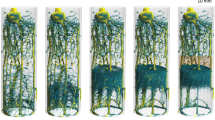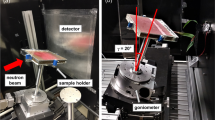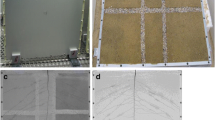Abstract
Background
Our recent publication (Warren et al., Plant Soil 366:683–693, 2013) described how pulses of deuterium oxide (D2O) or H2O combined with neutron radiography can be used to indicate root water uptake and hydraulic redistribution in maize. This technique depends on the large inherent differences in neutron cross-section between D and H atoms resulting in strong image contrast.
Scope and Conclusions
However, as illustrated by Carminati and Zarebanadkouki (2013) there can be a change in total water content without a change in contrast simply by a change in the relative proportions of D2O and H2O. We agree with their premise and detailed calculations (Zarebanadkouki at al. 2012, 2013), and present further evidence that mixing of D2O and H2O did not confound evidence of hydraulic redistribution in our study.
Similar content being viewed by others
Avoid common mistakes on your manuscript.
Commentary text
Substantial advances in neutron radiography and computed tomography are leading to new insights of plant-soil water relations and water flux (Matsushima et al. 2009; Warren et al. 2013; Zarebanadkouki et al. 2013). Alternating application of D2O and H2O to a plant soil system allows for visualization of soil water movement, root water uptake, and even hydraulic redistribution of water within the roots system (Warren et al. 2013). Quantification of absolute flux is difficult, due to mixing of the two liquids, and potential differential absorbance and movement within the soil matrix, concurrent with evaporation and root water extraction. Recent work by Zarebanadkouki et al. (2012, 2013) developed a set of mixing equations that can partition the relative contribution of D2O and H2O within a neutron radiograph, which can be used along with modeled diffusive and convective flow of water into and through roots to estimate flux. Carminati and Zarebanadkouki (2013) highlight the difficulty of water flux assessment under specific conditions: when there is no change in neutron image contrast through time, yet there is known water movement through the system. This condition can occur based on shifts in the relative proportions of D2O and H2O. D has a much lower neutron cross section than H, thus large increases in D2O, balanced by small decreases in H2O can lead to a wetter system without any change in image contrast. In our sand-maize model system, D2O surface irrigation led to differential soil moisture content though the profile, leaving a significant area apparently dry (Warren et al. 2013). Roots terminating in this dry area became rehydrated over time, indicating hydraulic redistribution. A closer look at the system indicates this hydraulic redistribution was not confounded by mixing of D2O and H2O. Even so, several areas distant from the roots did show no change in neutron image contrast despite an increase in total water content, confirming the thesis of Carminati and Zarebanadkouki (2013).
In our sand-maize model system, much of the soil was visibly wetted by the deuterium immediately following irrigation (Fig. 1). Within the upper profile, the D2O mixed with and displaced some of the existing water, resulting in a rapid increase in image intensity (brighter and wetter) since the neutron cross-section for D is much lower than for H (Fig 1a-c, location 1). Location 2 had a rapid reduction in image intensity (darker and wetter) as some of the D2O and H2O mixture pushed into a previously dry area. Location 3 and 4 had no change in image intensity, and was presumably dry. The roots that experienced HR were bound by location 3 and 4. There was no visible change in this ‘dry’ area, no indication of any progressive change in contrast within ~5 mm on either side of the roots, suggesting little soil water availability for root uptake that could confound our evidence of hydraulic redistribution. Locations 5–7 had a rapid reduction in image intensity as D2O, mixed with H2O moved through the soil profile. Similar results are illustrated moving through the soil profile pixel by pixel (Fig. 1d). There were two locations along the A-B transect (Fig. 1b) that had no change in pixel intensity despite wetter soil conditions (Fig. 1d, at 4.1 and 8.2 mm depths). These two locations do support the issues raised by Carminati and Zarebanadkouki (2013). Further neutron imaging experiments and modeling will be necessary to refine estimates of soil water extraction by roots. New approaches, such as use of monochromatic neutron beam lines, or selection of specific wavelength ranges that interact differentially with D and H (e.g., from a pulsed spallation neutron source) may further application of neutron imaging to study plant water relations.
a 120-sec neutron radiograph of single maize seedling growing in sand. Bulk water content is 0.044 cm3 cm-3, with most of the ~ 1 ml of water located near the seed hull at the top of the chamber, indicated by darker regions. b 120-sec neutron radiograph of (a) initiated two minutes after addition of 3 ml D2O to the soil surface. Bulk water content is 0.199 cm3 cm−3, with visibly wet and dry areas indicated. c time series of the absolute pixel image intensity (scale 0–64000) of seven selected soil regions through the vertical profile. d change in pixel intensity with depth along a transect from A to B as depicted in (b)
References
Carminati A, Zarebanadkouki M (2013) Comment on: “Neutron imaging reveals internal plant water dynamics”. Plant Soil 369:25–27. doi:10.1007/s11104-013-1780-3
Matsushima U, Herppich WB, Kardjilov N, Graf W, Hilger A, Manke I (2009) Estimation of water flow velocity in small plants using cold neutron imaging with D2O tracer. Nucl Instrum Meth A 605:146–149
Warren JM, Bilheux H, Kang M, Voisin S, Cheng C, Horita J, Perfect E (2013) Neutron imaging reveals internal plant water dynamics. Plant Soil 366:683–693
Zarebanadkouki M, Kim Y, Moradi A, Vogel HJ, Kaestner A, Carminati A (2012) Quantification and modeling of local root water uptake using neutron radiography and deuterated water. Vadose Zone J 11 doi 10.2136/vzj2011.0196
Zarebanadkouki M, Kim YX, Carminati A (2013) Where do roots take up water? Neutron radiography of water flow into the roots of transpiring plants growing in soil. New Phytol. doi:10.1111/nph.12330
Author information
Authors and Affiliations
Corresponding author
Additional information
Responsible Editor: Rafael S. Oliveira.
Rights and permissions
About this article
Cite this article
Warren, J.M., Bilheux, H., Cheng, CL. et al. Reply to: Comment on ‘neutron imaging reveals internal plant water dynamics’. Plant Soil 371, 15–17 (2013). https://doi.org/10.1007/s11104-013-1858-y
Received:
Accepted:
Published:
Issue Date:
DOI: https://doi.org/10.1007/s11104-013-1858-y





